Also published at Thunderbolts.info
In Part 1 of Sputtering Canyons, we discussed Arches National Monument, and evidence it was formed by a complex sputtering discharge process. That process involved a thermal spiking, barrier discharge in a layer of wet sandstone.
In Part 2, we’ll take a broader look at some regions on the Colorado Plateau where similar sputtering discharge processes took place.
One of these is Monument Valley. Monument Valley was formed by sputtering discharge that almost completely etched a layer of the original dome away. What is left are the lonely pinnacles and buttes iconic to Western movies.

The reason these pinnacles and buttes are left standing, while the same layers of sandstone etched away around them, is due to preferential sputtering. Preferential sputtering is normally associated with sputtering an alloyed metal where one element in the alloy sputters more efficiently, eroding away faster than the other alloy metal.
In Monument Valley, the buttes and pinnacles left standing were portions of the dome that resisted sputtering because of a difference in charge density. The part of the dome that lifted away, did so when the wet layer – the icing in the layer cake – became a charged, hot ionized mud. A sheet of high charge density developed at the base of the mud with an attraction to the clouds above – and like an electromagnet picks up a junk car – the storm’s electric field lifted away the overburden to dissolve in electric winds.
The buttes and pinnacles are remnants that didn’t have the same charge in their wet layer, so they didn’t get pulled away by the electric field. The reason is: they were struck by lightning.
In the dark mode, drifting plasma current that causes sputtering, there is always the potential to spark. Manufacturers are careful to avoid this because it will flaw the finished surface. The pinnacles and buttes were parts of the dome where an arc, or many arcs struck and dissipated built-up charge. Instead, it altered the ground charge beneath the strike zone so the electric field couldn’t pull it away. Therefore, the buttes and pinnacles were preferentially – not sputtered.
In the parlance of the semiconductor industry, the charged layer was doped by the presence of water and minerals, which gave it an excess of electrons. When lightning struck, it depleted the charge and left an excess of “holes”, or the absence of electrons, which cancelled the attractive force of the sputtering discharge.
The evidence for this is manifold. To begin, consider the cap rock formations and spires found on buttes. Butte tops aren’t flat. They generally have something like a step pyramid, dome, or pinnacle on top, which is where lightning discharge was most intense.
Notice, in the images below, the pyramidal caps. The rock below the caps is darkened significantly more than adjacent stone. Not only is there black patina, but there is also more redness to the rock itself in streaks below the caps, with deep vertical fracturing. The charge depletion from lightning, and the subsequent recombination of the most severely depleted zones beneath where it struck, heated, shocked and hardened the rock more in these areas than in others.

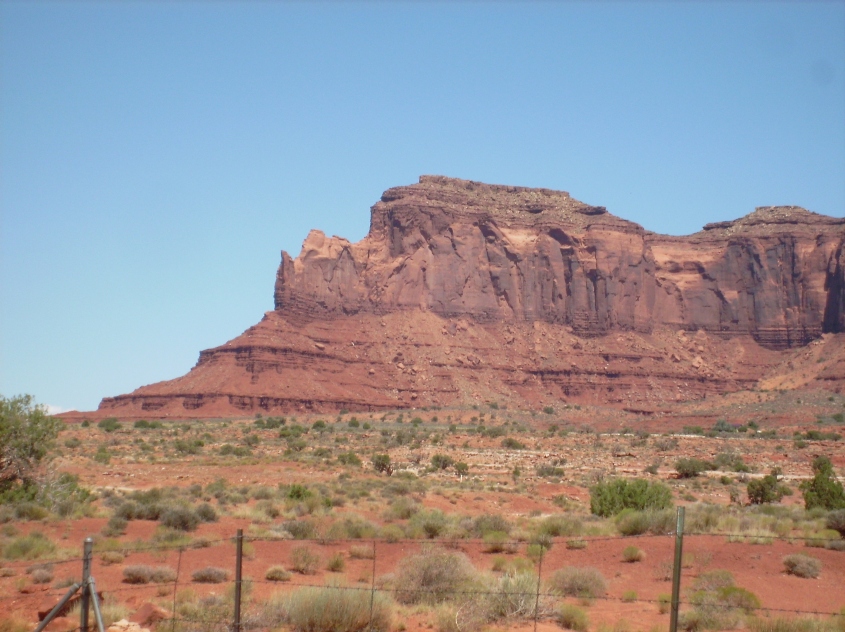 The step pyramid structure, or terracing on canyon walls and buttes is another evidence of sputtering. Each sedimentary layer has different compositions of minerals and moisture, differentiating the dielectric property of each layer. The zone of charge depletion under lightning strikes spreads out in a conical diffusion pattern, but the cone is stepped, or terraced, because there is a step voltage across each dielectric layer.
The step pyramid structure, or terracing on canyon walls and buttes is another evidence of sputtering. Each sedimentary layer has different compositions of minerals and moisture, differentiating the dielectric property of each layer. The zone of charge depletion under lightning strikes spreads out in a conical diffusion pattern, but the cone is stepped, or terraced, because there is a step voltage across each dielectric layer.
 Where there are towering cliffs with sheer vertical walls, it is because it is a monolithic layer with a consistent dielectric, causing a single large voltage step.
Where there are towering cliffs with sheer vertical walls, it is because it is a monolithic layer with a consistent dielectric, causing a single large voltage step.

Where there is very hard rock, the edges are torn in chunky blocks. The flat, smooth breaks are not the result of millions of years of erosion of any type – wind, rain, ice, exfoliation, or flowing water. Any of those actions would have the opposite effect. The rocks have such smooth, flat faces, and sharp, angular, undercut edges because they were broken by mechanical shearing as the neighboring rock was ripped away.
 Evidence of shearing is especially evident on monolithic walls. Sharp edged breaks are everywhere, leaving smooth, flat faces, hardly roughened, or rounded by any act of erosion.
Evidence of shearing is especially evident on monolithic walls. Sharp edged breaks are everywhere, leaving smooth, flat faces, hardly roughened, or rounded by any act of erosion.
Arching fissures are evidence of spalling, where the material tore away in flakes, cupped upward in the direction of shear. The arches often show concentric creases where flakes broke away in smaller sections deeper into the rock. One can see the same type of concentric flaking in broken glass.
In some places the canyon walls have the look of broken glass. In others it looks more like the broken end of a brick of hard cheese. Perhaps a well-aged Parmesan – stiff, dry and flaky, with a low shear strength.



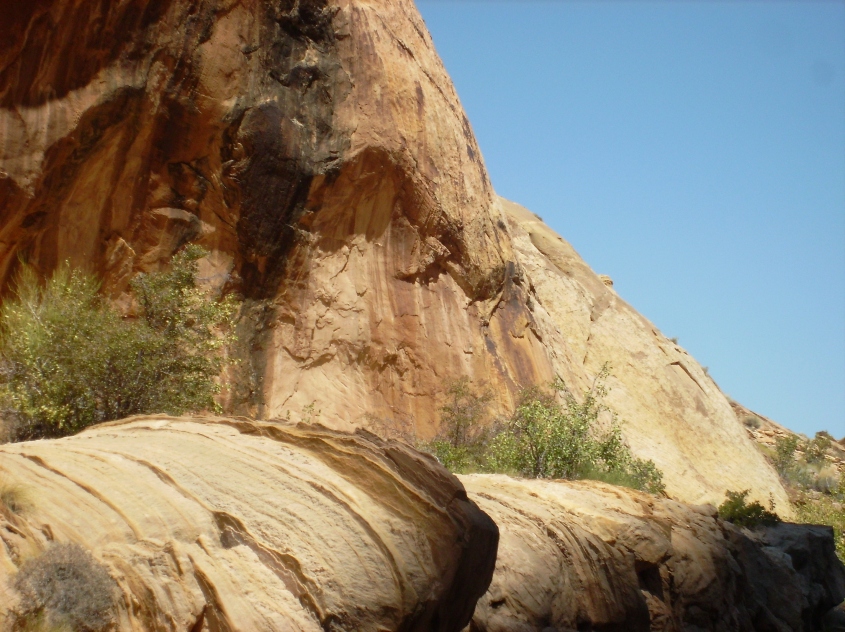


Besides cupping spalls, some surfaces show other evidence of stress fracturing due to shearing force.

There is almost always a thin layer of hardened rock at the interface of each terrace. This is where charge accumulated at the boundary layer of the strata, and the current hardened the charged sheet of rock more so than the surroundings.
Each dielectric layer spreads charge to the interface of its layer, driven by the electric field, to balance the voltage drop across the layer. So a charged sheet develops at the interface of each layer, and a step voltage to the next layer, which creates a surface tension at the interface, which makes the rock hard and dense. What is sandwiched between is often loosely consolidated.
 Pinnacles in this region are of two types. Fulgarites, like the burnt shard of Agathla peak, are the direct result of lightning boiling up the crust of the earth in an electromagnetic blister. These types of pinnacles were discussed in Lightning Scarred Earth, Parts 1 and 2.
Pinnacles in this region are of two types. Fulgarites, like the burnt shard of Agathla peak, are the direct result of lightning boiling up the crust of the earth in an electromagnetic blister. These types of pinnacles were discussed in Lightning Scarred Earth, Parts 1 and 2.

Sandstone pinnacles are where lightning struck and altered the charge in the rock beneath it, creating an electrical ‘shadow’ to sputtering discharge. They are literally, the shadow of lightning strikes.
The footprint of a ‘brief’ strike, comparatively speaking, produces a narrow cone of protection. How the cone slopes and steps depends on properties of the rock layers and the electric field potential.
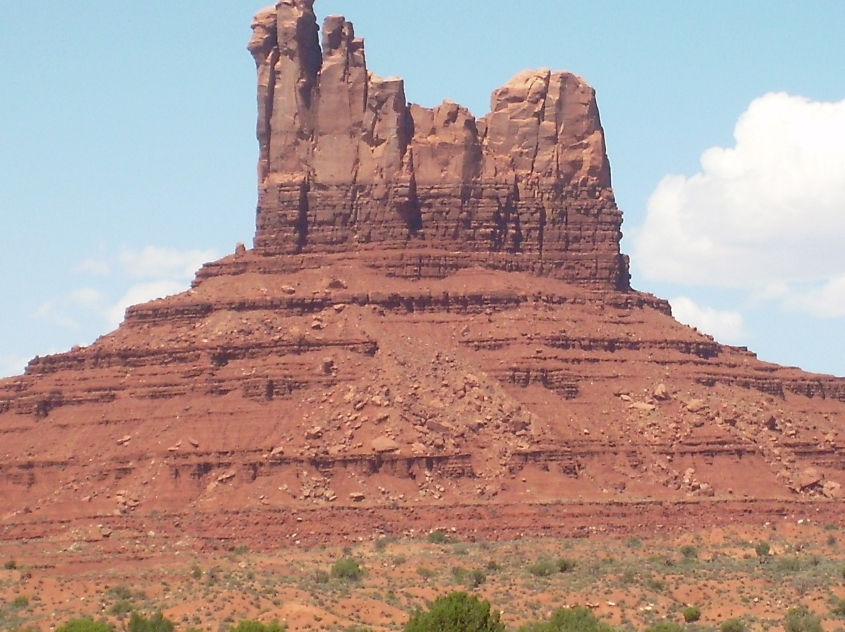 More sustained, or potent striking begins to diffuse charge depletion outward, forming nodes, or star like breakouts.
More sustained, or potent striking begins to diffuse charge depletion outward, forming nodes, or star like breakouts.
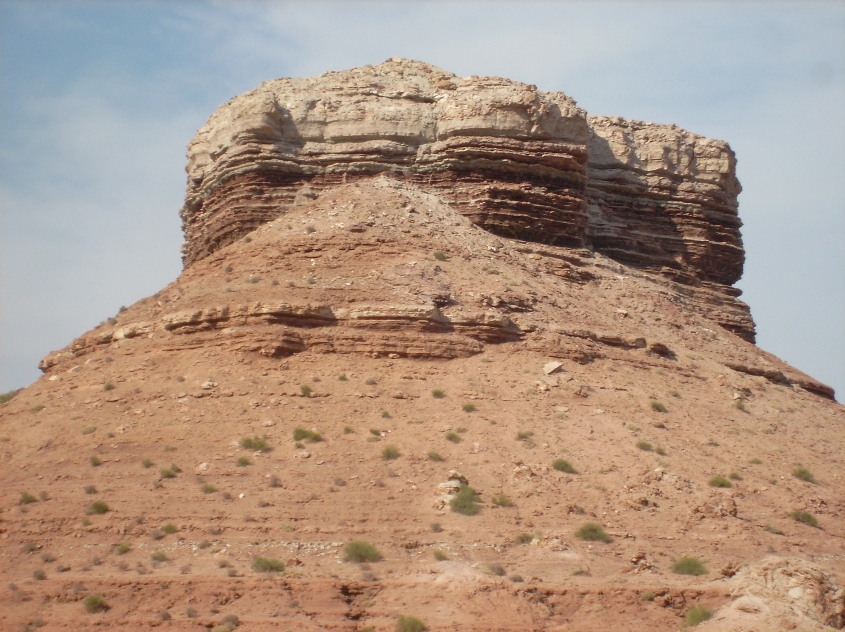 Still larger accumulation of strikes, diffuses charge further, and nodules break out into ‘wings’, or dykes of charge depleted rock.
Still larger accumulation of strikes, diffuses charge further, and nodules break out into ‘wings’, or dykes of charge depleted rock.


 The shadow footprint grows as arcing continues, elongating charge depleted zones into wedges with dykes growing out the tips and edges. It’s actually the beginning of a fractal dendrite, as lightning bombardment soaks charge from the ground, diffusing outward in branches and creating a depleted zone protected from sputtering. If the process continued before the surroundings sputtered away, the dendrite nodules would grow and branch in ever smaller fractal repetitions, like branches of a tree.
The shadow footprint grows as arcing continues, elongating charge depleted zones into wedges with dykes growing out the tips and edges. It’s actually the beginning of a fractal dendrite, as lightning bombardment soaks charge from the ground, diffusing outward in branches and creating a depleted zone protected from sputtering. If the process continued before the surroundings sputtered away, the dendrite nodules would grow and branch in ever smaller fractal repetitions, like branches of a tree.




 As adjacent rock is struck, the depleted zones connect into networks of wedges, ridges and pinnacles.
As adjacent rock is struck, the depleted zones connect into networks of wedges, ridges and pinnacles.

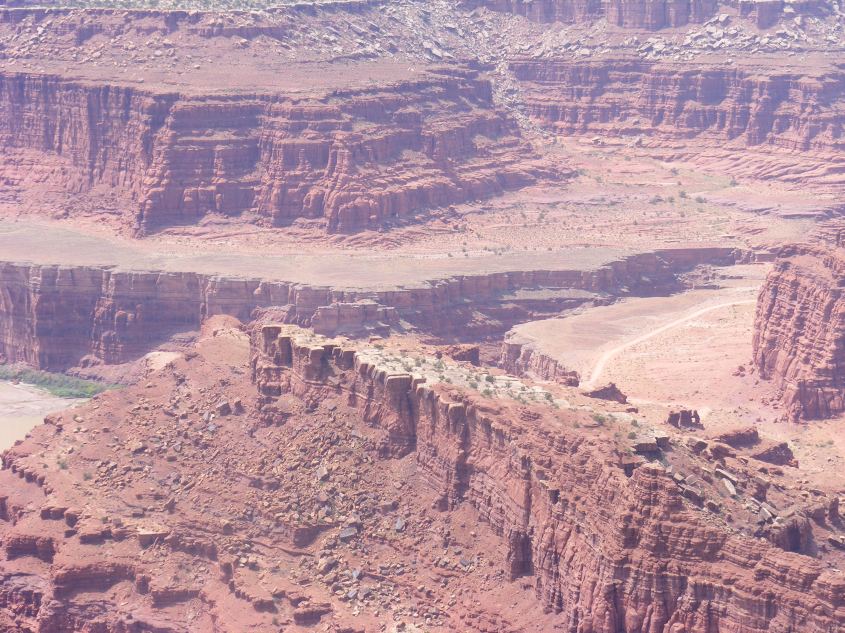

 Generally, the pinnacles and buttes left on a dome are layered flat, but in some areas buttes display a dip, indicating horizontal winds influenced the deposition. Sputtering follows the voltage gradient, and so carves away from the lightning depleted zone in alignment with the strata because the voltage gradient follows the dielectric layers, cutting at 90º to the dip angle, leaving a straight-edged non-vertical wall. If eroded by conventional notions of wind, rain and mass wasting, the rock would obey gravity and erode a vertical wall. It is in details like this that prove electrical formation.
Generally, the pinnacles and buttes left on a dome are layered flat, but in some areas buttes display a dip, indicating horizontal winds influenced the deposition. Sputtering follows the voltage gradient, and so carves away from the lightning depleted zone in alignment with the strata because the voltage gradient follows the dielectric layers, cutting at 90º to the dip angle, leaving a straight-edged non-vertical wall. If eroded by conventional notions of wind, rain and mass wasting, the rock would obey gravity and erode a vertical wall. It is in details like this that prove electrical formation.
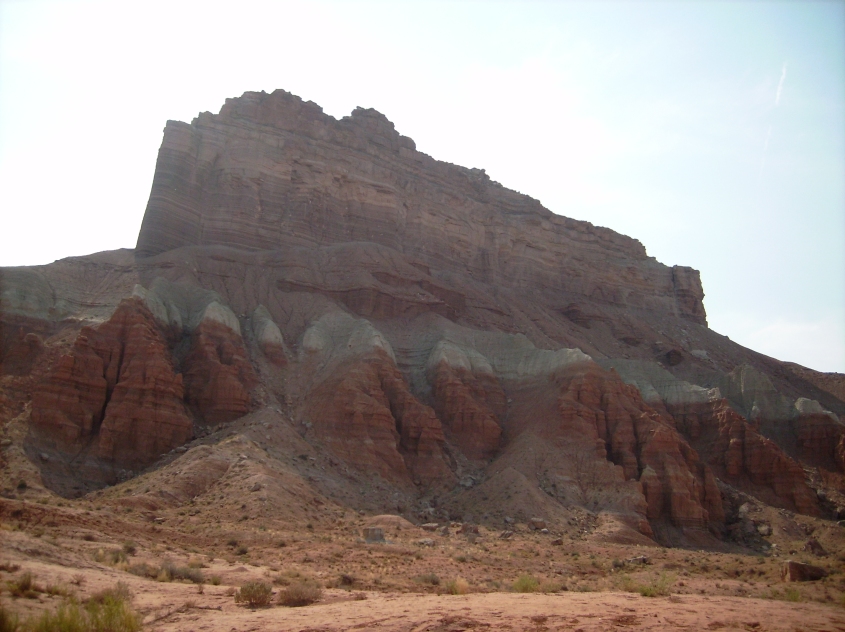 What we see in the stepped pyramids and terraced canyons is the result of two types of charge transport in a solid state matter. One is drift ionization caused by the external electric field of the storm, and the other is diffusion current caused by differences in charge density within the material of the dome.
What we see in the stepped pyramids and terraced canyons is the result of two types of charge transport in a solid state matter. One is drift ionization caused by the external electric field of the storm, and the other is diffusion current caused by differences in charge density within the material of the dome.
Drift current is the flow of charge created by the external electric field of the storm, which primarily drives the ionized region downward, vertically through the layers of sandstone. Drift currents obey Ohm’s Law.
Diffusion current obeys Fick’s Law, which is related to Ohm’s Law, but accounts for variations in charge density that causes ionization to migrate from a region of high charge concentration, to a region of low concentration. No external electric field is needed for diffusion current, because the difference in charge concentrations creates a gradient between regions that results in a local electric field. This is the primary process that migrates charge horizontally – spreading out through each layer of sandstone.
What is carved away by sputtering leaves distinct scalloped edges in very dry, low conductivity material. The scalloping is a fractal phenomena of electrical diffusion that repeats the scallop shape in ever larger scallops.

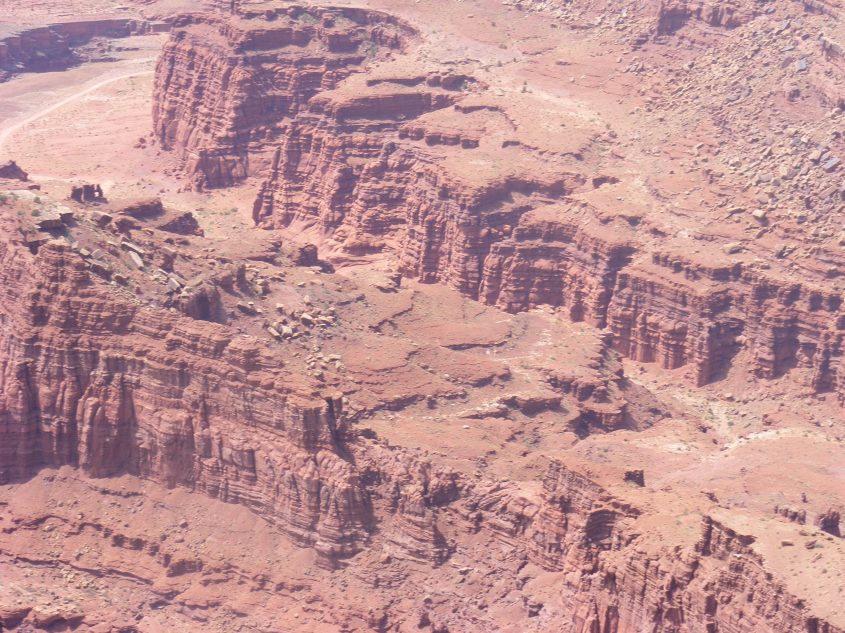


In wetter environments this isn’t as apparent, or it may be totally absent, because water diffuses charge more evenly, creating smoother surfaces.

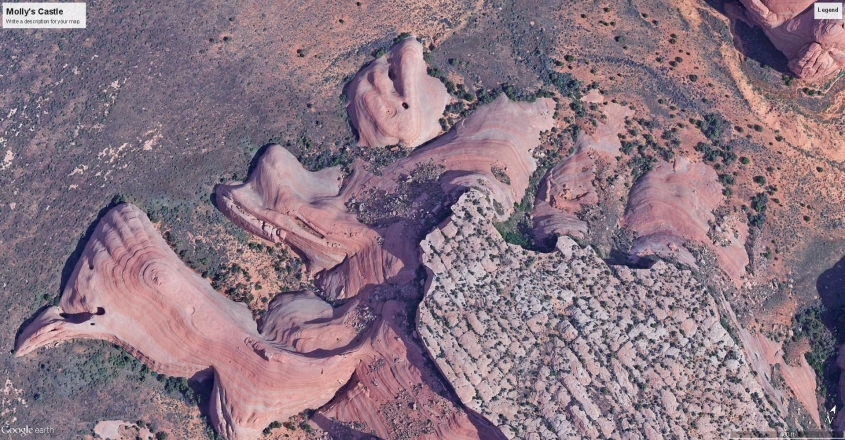 Compelling evidence the scalloped and terraced walls are a result of charge diffusion is shown in this image, where the archetype of all fractal shapes emerges – the Mandlebrodt Set.
Compelling evidence the scalloped and terraced walls are a result of charge diffusion is shown in this image, where the archetype of all fractal shapes emerges – the Mandlebrodt Set.
Although it’s not a computer perfect rendition of the Mandlebrodt Set, it is nearly so. It’s a naturally generated fractal based on the same mathematical relationships of iterating three dimensional motion that governs electrical charge diffusion in solid state electronics.
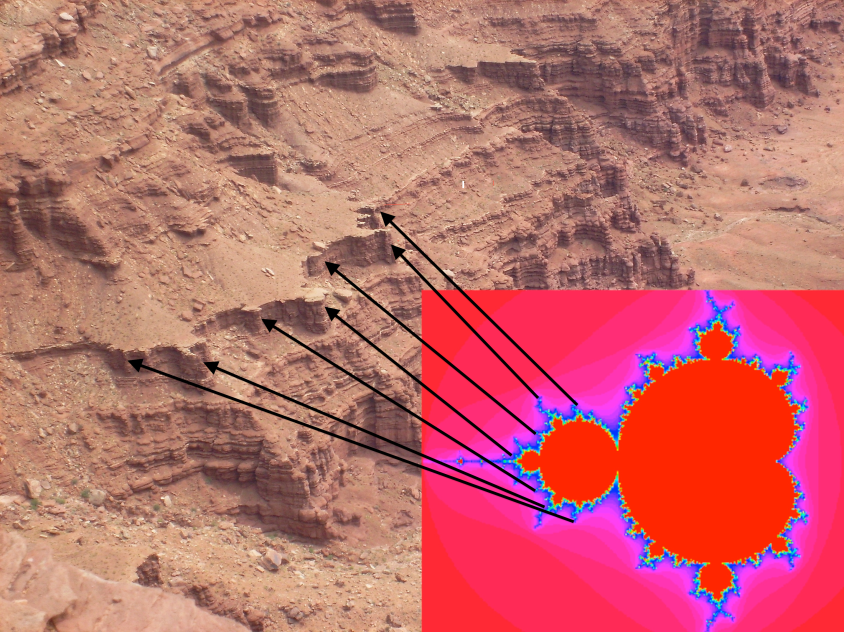


The implication is obvious. The shape of the canyon walls, the terracing, the fractal repetition of form – everything known about applied physics dictates this is the result of electrical current diffusion on a continent-scale semiconductor under the influence of a gigantic electric field. The physics is not only laboratory proven, it’s been used to make every semiconductor device ever manufactured.
In fact, geophysicists and even Hollywood CGI artists, simulate geologic forms like watersheds and river systems, canyons and mountains, using the fractal geometry of electrical diffusion. So, what is being described here has been acknowledged by consensus science. The scientific conclusion that these land forms are the result of electrical diffusion caused by an intense electric field influencing Earth’s crust, in an event in the manner Electric Universe theorists have described since Immanuel Velikovsky, is scientifically unavoidable.
Yet avoid it they do – consensus science, that is. To quote from a Wikipedia article on diffusion:
“Analytical and numerical models that solve the diffusion equation for different initial and boundary conditions have been popular for studying a wide variety of changes to the Earth’s surface. Diffusion has been used extensively in erosion studies of hill slope retreat, bluff erosion, fault scarp degradation, wave-cut terrace/shoreline retreat, alluvial channel incision, coastal shelf retreat, and delta pro-gradation. Although the Earth’s surface is not literally diffusing in many of these cases, the process of diffusion effectively mimics the holistic changes that occur over decades to millennia.”
Do you see what is going on here? Geophysics uses diffusion models to recreate Nature’s landscapes – they use the mathematics and physics of charge diffusion to do it, but don’t understand why – they think it’s just a coincidence. Rather than conclude from empirical data they have in hand, in proper scientific fashion, that electric current diffusion has a role in shaping the landscape, they conclude it’s just coincidence.
One hates to be critical of hard working geophysicists, but to have an empirically proven answer staring you in the face – and even be using it, with great success, as your model – and still ignore it in favor of a preferred narrative, is what a politician does, not a scientist. The idea that diffusion “mimics the holistic changes that occur over decades to millennia” is nothing less than absurd.
Diffusion is caused by charge transport from higher to lower concentrations. It’s an inside-out physical phenomena. It occurs at the atomic level, where charge diffuses from atom-to-atom, and then works its way out with secondary effects to produce the macro-fractal patterns we can see. Conventional erosive forces of water, wind and ice act on the land from the outside in, not from the inside out. They can’t possibly produce the kind of landscapes we actually see, and that is why they cannot be modeled with hydrodynamics, or any of the unverifiable effects of slow random forces of wind, ice and water acting over millions of years.
Scientists are forced to use electrical diffusion to model the obviously fractal and non-random forms on the landscape because it’s the only model that works, yet are so invested in scientific dogma they can’t see the discovery they made. It verifies everything I’ve said, so I appreciate they’ve already proven my case. But their notions violate physics, which is something they obviously don’t understand, so they call it a coincidence instead.
Fortunately, in EU we like to deal in truths. In Part 3, we’ll examine a few more examples of Sputtering Canyon evidence.

This keeps getting better. Your writing and my ability to understand what you’re saying are both more or less continually improving. Thanks for the teachings.
LikeLike
Thank you so much for your fascinating work!
It is astounding to me that the oligarchs can keep such obvious evidence away from smart scientists for so long.
On Tue, Apr 10, 2018 at 2:45 PM The Daily Plasma wrote:
> A. D. HALL posted: “Also published at Thunderbolts.info In Part 1 of > Sputtering Canyons, we discussed Arches National Monument, and evidence it > was formed by a complex sputtering discharge process. That process involved > a thermal spiking, barrier discharge in a layer of wet ” >
LikeLike
Andy! You have done it again! I can get a handle on what I am seeing when in Utah. This is the Hall Effect I can get behind!
Larry
LikeLike
Reblogged this on The Universe is Between Your Ears and commented:
It’s becoming evident that many of our planet’s features we’d believed were formed over “geological time periods” were actually formed quickly, and recently.
LikeLiked by 1 person
Hey Joe, Thanks for the re-blog!
LikeLiked by 1 person
You’re welcome. Thanks for putting these together. (For some reason, your post wasn’t actually reblogged on my blog, so gonna try it again.)
LikeLike